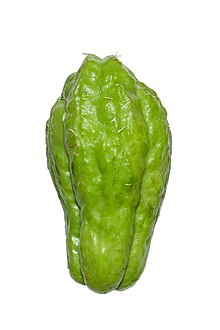Sechium edule
| Chayote | |
|---|---|
 |
|
| Chayote fruit | |
 |
|
| Chayote fruit cross section | |
| Scientific classification | |
| Kingdom: | Plantae |
| (unranked): | Angiosperms |
| (unranked): | Eudicots |
| (unranked): | Rosids |
| Order: | Cucurbitales |
| Family: | Cucurbitaceae |
| Genus: | Sechium |
| Species: | S. edule |
| Binomial name | |
|
Sechium edule (Jacq.) Sw. |
|
| Synonyms | |
| Nutritional value per 100 g (3.5 oz) | |
|---|---|
| Energy | 80 kJ (19 kcal) |
|
4.51 g
|
|
| Sugars | 1.66 g |
| Dietary fiber | 1.7 g |
|
0.13 g
|
|
|
0.82 g
|
|
| Vitamins | |
| Thiamine (B1) |
(2%)
0.025 mg |
| Riboflavin (B2) |
(2%)
0.029 mg |
| Niacin (B3) |
(3%)
0.47 mg |
| Pantothenic acid (B5) |
(5%)
0.249 mg |
| Vitamin B6 |
(6%)
0.076 mg |
| Folate (B9) |
(23%)
93 μg |
| Vitamin C |
(9%)
7.7 mg |
| Vitamin E |
(1%)
0.12 mg |
| Vitamin K |
(4%)
4.1 μg |
| Minerals | |
| Calcium |
(2%)
17 mg |
| Iron |
(3%)
0.34 mg |
| Magnesium |
(3%)
12 mg |
| Phosphorus |
(3%)
18 mg |
| Potassium |
(3%)
125 mg |
| Zinc |
(8%)
0.74 mg |
|
|
|
|
|
| Percentages are roughly approximated using US recommendations for adults. Source: USDA Nutrient Database |
|
Chayote (Sechium edule) is an edible plant belonging to the gourd family Cucurbitaceae, along with melons, cucumbers and squash. Globally it is known by many names including chayote, cho-cho, christophine cho-cho,pipinola (Hawaii), pear squash, vegetable pear,choko (Australia). Its tuberous and edible root is called chinchayote or chayotextle in Mexico and ichintal or güisquil in Guatemala.
Chayote is originally native to Mesoamerica. It has been introduced as a crop worldwide. The main growing regions are Brazil, Costa Rica, Veracruz, Mexico and Abkhazia. Costa Rican chayotes are predominantly exported to the European Union, whereas Veracruz mainly exports its chayotes to the United States.
The word chayote is a Spanish derivative of the Nahuatl word chayohtli (pronounced [t͡ʃaˈjoʔt͡ɬi]). Chayote was one of the many foods introduced to Europe by early explorers, who brought back a wide assortment of botanical samples. The Age of Conquest also spread the plant south from Mexico, ultimately causing it to be integrated into the cuisine of many other Latin American nations.
The chayote fruit is used in mostly cooked forms. When cooked, chayote is usually handled like summer squash, it is generally lightly cooked to retain the crispy consistency. Though rare and often regarded as especially unpalatable and tough in texture, raw chayote may be added to salads or salsas, most often marinated with lemon or lime juice. Whether raw or cooked, chayote is a good source of vitamin C.
...
Wikipedia
